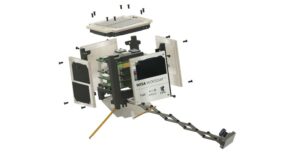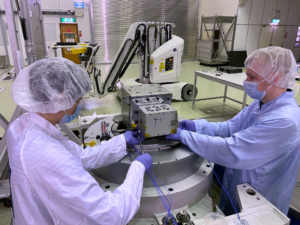Low Earth orbit (LEO) is a useful place to put a satellite. In addition to protection from interstellar radiation, the altitude between 160 km and 1,000 km above the Earth’s surface offers rapid communications with the ground, an excellent vantage point for Earth observation and a comparatively cheap cost of access.
It’s also getting crowded. Thanks to the rise of affordable, open-source nanosatellite designs and private launch companies that allow satellite operators to share launch costs, nearly 1,200 satellites were sent into orbit over the course of 2020—more than twice as many as in 2019. With few operators taking on the task of disposing their satellite at the end of its lifecycle, the result is a growing accumulation of thousands of discarded spacecraft, together with millions of pieces of smaller metallic debris that break off when they collide.
“This debris is completely uncontrolled, and you can’t maneuver it out of the way, so there’s a higher risk of collision with an active spacecraft,” says Riccardo Rampini, head of materials’ physics and chemistry at the European Space Agency (ESA). “It’s becoming increasingly dangerous for other space missions.”

One way to avoid contributing to this great orbital garbage sphere is to deorbit the satellite by slowing its speed, which causes it to drop out of orbit. Ideally, it would burn up upon reentry to the atmosphere, during which temperatures can reach over a thousand degrees centigrade. But metal doesn’t vaporize easily. Large parts, such as aluminum body panels, can make it through to rain down upon the Earth’s surface—constituting a potential hazard to those of us who live upon it.
This growing need to take responsibility for a satellite’s entire lifecycle explains Rampini’s interest when, last November, Finnish space education company Arctic Astronautics contacted the ESA with a suggestion: Why not use a material that would not only burn up much more quickly in the atmosphere, making for easier disposal, but something that is also lighter than aluminum, cheaper than carbon fiber and has much better ecological credentials at the manufacturing stage? Why not make a satellite out of plywood?
A 4,000-year-old natural composite
As a model aircraft hobbyist, Arctic Astronautics co-founder Jari Makinen was familiar with the aeronautical advantages of plywood’s strength-to-weight ratio and had long been thinking about the possibility of using it in satellites. When he heard about plans by a team from Kyoto University to test how wood behaves when exposed to space, Makinen decided the time had come to put the idea into practice.
To create the WISA Woodsat, Arctic Astronautics selected birch plywood from Finnish forestry company UPM, manufactured from thin veneers of wood, layered at 90-degree angles to each other and bonded together with a plant-based glue. Both UPM and the ESA’s tests indicate this glue will also be able to withstand the conditions of LEO.

“Plywood is basically a natural composite,” Makinen explains. “One problem you have with natural materials like wood is the grain structure. This can make it crack easily, which would be a problem with the vibrations involved in a launch. In plywood, the grains are layered perpendicular to each so it’s very strong and less prone to cracking or splintering.”
Beyond affordability and clean combustibility, wood has other advantages when it comes to dealing with the harsh extremes of life outside our atmosphere, where a satellite cycles between unshielded exposure to the sun’s rays in one moment before being plunged into the freezing cold of the Earth’s shadow in the next.
“Wood is stable for a wide range of temperature from minus 150°C up to plus 150°C,” explains Takao Doi, former astronaut and head of Kyoto University’s LignoStella project, which will begin testing a sample of treated wood on the International Space Station in December of 2021, with intentions to build a wooden satellite for launch by 2023. “It also lets electromagnetic waves and magnetic fields pass through it and could simplify the design of satellites by allowing antennae to be contained inside the satellite body.”
Withstanding a volatile environment
Thanks to Arctic Astronautics’ experience in building functioning nanosatellites for educational demonstrations, designing their 10 cm-squared WISA Woodsat was relatively straightforward. But the company has never actually sent anything into space before. So Rampini’s team at the ESA offered to provide their expertise on the kind of conditions the Woodsat could expect to face and to help test its ability to withstand them.
The first challenge is outgassing, which occurs when a moist material is exposed to the vacuum of space, vaporizing the water inside it. This not only threatens to deform the structure but also releases other chemicals from inside the material that can contaminate sensitive scientific instruments and condense upon solar panels, damaging their efficiency.

To prevent this, the Woodsat’s plywood panels have been baked in a vacuum oven to extract as much moisture as possible, then coated in a nanometer-thick layer of aluminum to prevent any residual moisture and contaminants escaping once it’s in space. That aluminum layer plays a second role in protecting the plywood against the particularly volatile atmospheric conditions of LEO.
“The major problem for any biomaterial in LEO is atomic oxygen,” explains the Woodsat’s chief engineer, Samuli Nyman.“Normally, oxygen is O2, and it’s happy with that configuration. In space, it’s single atoms, which are super reactive with biomaterials or basically anything that would burn.”
Unlike on Earth, this reaction won’t produce any flames, but it will cause discoloration to the satellite’s surface that can be used to assess the material’s rate of deterioration. To monitor this, the Woodsat has been equipped with a camera mounted on an extendable arm that will regularly transmit pictures of its exterior. In addition, the ESA has supplied a pressure sensor to detect outgassing and an extremely sensitive quartz crystal microbalance that will monitor any build-up of contaminants in the satellite.
Future-proofing Earth’s orbit
Following a successful stratospheric balloon flight in June to test these onboard systems, Woodsat is scheduled for launch with private space company Rocket Lab Electron from their launch complex in Mahia, New Zealand, in the first half of 2022—subject to the granting of a payload permit by the New Zealand government and a commercial radio license from the International Telecommunications Union.
Both Mankinen and Rampini see the project as an explorative one aimed at better understanding the performance of novel materials for space applications, not as a prototype for future nanosatellite designs. As Rampini points out, the key advantage of plywood comes into play with larger constructions. Here, plywood’s combustibility upon reentry to the atmosphere could allow for easier and safer deorbiting in comparison to aluminum parts, which require more care to ensure that chunks of metal don’t make it through to fall upon populated parts of the Earth’s surface.

Yet with plans by private companies, such as SpaceX and OneWeb, to launch constellations of thousands of communications satellites, some as large as a meter cubed, the need for creative solutions to ensure the sustainability of orbital missions is more pressing than ever.
“I remember when I was a kid, satellite launches were really rare, and it was this huge occasion,” says Rampini. “But it’s incredible how frequently things are being launched these days. This is the time to start tackling the problem of space debris.”
Lead rendering courtesy of WISA Woodsat/Arctic Astronautics

